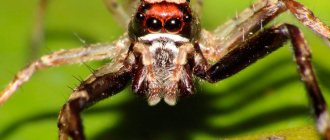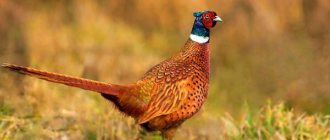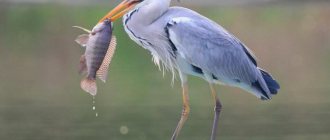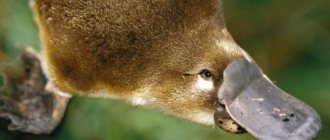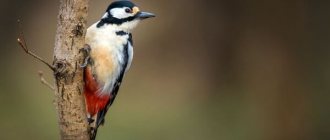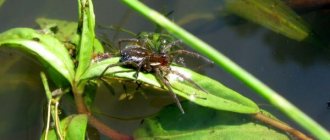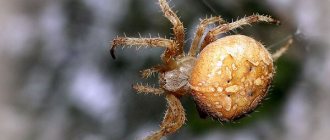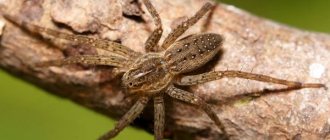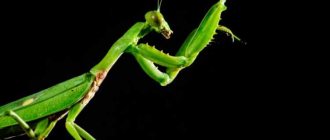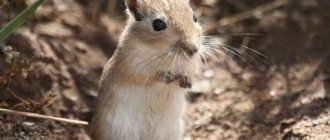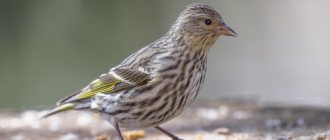- Wild animals
- >>
- Arachnids
The prevalence of sexual cannibalism, in which the female eats the male after mating, influenced the species' common name, black widow . This species is considered to be one of the most poisonous. The venom of a female spider exceeds the toxicity of toxic substances in a rattlesnake. However, only a female bite is dangerous to humans. The bites of male and teenage spiders are harmless.
Where does the black widow spider live?
- The black widow spider can be found in Russia. But, it lives more in warm regions (Astrakhan, Kalmykia and the Azov region). According to statistics, dangerous spiders have bitten people in the Orenburg, Saratov and Kurgan regions. In 2022, many cases of bites appeared in the Moscow region.
- In Russia, the spider Latrodectus tredecimguttatus, which is one of the varieties of the Black Widow, is often found. Its venom contains only 0.59 mg/kg of the neurotoxin LD 50.
- And in the spider Latrodectus mactans the amount of this substance reaches 0.9 mg/kg. This is why Russian spiders are less dangerous to humans.
Death spiders live in hot regions of North America. In the last few years, they have begun to be noticed even in the Crimea and Moscow region. Scientists are convinced that this is due to climate change around the world.
Habitat
This type of spider is distributed throughout the world. They live in regions with temperate climates, incl. in the USA, Southern Europe, Asia, Australia, Africa and much of South America. Can be found in dark, dry shelters, dimly lit areas such as barns, garages, basements, closets, hollow tree stumps, rodent holes, and dense vineyard vegetation. They strive to hide in warm dwellings in winter.
Although previously the black widow spider was not known in Russia, in recent years they have been discovered in the Southern Urals and in the Rostov region. The migration is explained by an increase in air temperature.
An important characteristic of the black widow is its shaggy paw-crests. A row of strong, curved bristles is located on the back pair of legs and is used to pull the web over captured prey
What does a black widow spider look like?
- Females and males differ in body size. The bodies of female spiders reach a length of 8-13 mm, and their weight is no more than 1 g. Females are characterized by a more rounded body shape. Color – rich black, with a glossy shine. Red spots can be seen on the back. They are presented in the shape of an hourglass.
- The male's body is not large. Only 4-6 mm. It has an elongated shape. There are white and red stripes on the sides of the belly. If the male is young, his body will be white. As it matures, it turns orange, brown and black.
- Female and male black widow spiders have 8 eyes. They are arranged equally, in two horizontal rows.
What does a black widow spider look like, photo
Social structure and reproduction
Photo: Black Widow
Black widows usually mate in the spring and summer. The female produces an egg mass containing about 200+ eggs. She covers the eggs with cobwebs, then forms a pouch from this, which should protect the eggs from external influences. The sac is suspended from a web to keep it away from predators.
It takes about two weeks for the eggs to hatch. Very few young spiders survive because they eat each other as soon as they are born. Spiderlings molt several times before reaching maturity. Diet and temperature are factors that influence the development of the offspring.
Remember! Females take 2 to 4 months to mature and their lifespan is about 1.1/2 years. Males mature in 2-4 months and live for about 4 months. They lose their outer covering (exoskeleton) as they grow.
Sexual contacts between mating spiders last longer if the male allows himself to be cannibalized. By sacrificing his life, he can fill his partner with more sperm. The female stores these sperm in two storage organs and can control when she uses these stored cells to fertilize her eggs.
If she has sexual intercourse again, the sperm of the second male may displace the sperm of the first. But females who eat their first mate are more likely to reject a subsequent one.
How does a black widow spider reproduce?
- After mating, the female eats the male. She weaves a cocoon where the laid eggs are placed. Most often, such cocoons are found in the shade (next to a stone, fallen tree or in the ground). The female does not go far from the clutch, and is always on guard. If you see a white cocoon, do not touch it with your hands. After all, this is when the black widow spider can bite.
- After 3 weeks, small spiders appear. They are characterized by white bodies. The female does not think about the fact that she needs to feed her offspring. Therefore, small spiders eat each other and only strong individuals emerge from the cocoon.
origin of name
The black spider with a red hourglass on its abdomen is well known throughout the world, not only because of its extremely toxic venom, but also because of its lifestyle. The male and female meet only to mate during the mating season. It is important for the “boyfriend” to calculate the mood of his “passion” in advance. A hungry female will eat her partner even before he begins his mating games. If the spider is waiting for the male, he calmly approaches her and does his job.
The fate of the “man” directly depends on his physical condition, as well as on how well-fed the female is. If the widow suddenly gets hungry, she will eat the “suitor” in an instant. The same thing happens to a weakened spider that has mated with several female spiders. A strong male can crawl away safely, and then appear again for another mating.
The arthropod received its second name - black death - due to its strong poison. The widow injects a toxic substance when bitten. The spider's venom kills a horse in a few minutes; in the absence of timely qualified assistance, a person dies within half an hour.
On a note!
The Latin name for the black widow, Latrodectus, comes from the Greek, literally meaning “biting in secret.” The spider hides in a secluded place, waiting for its victim. A person is attacked for the purpose of self-defense. The inconspicuous black color helps to camouflage at night, when animals are most active.
Black widow spider bite and venom
- Black widow spiders do not attack first. They attack an animal or person in self-defense . With the first bite, it injects a small amount of a poisonous substance that is not fatal. If a spider bites a child or an elderly person, the risk of death increases. After all, their immune system is not so strong and may not cope with the poison.
- The black widow's bite is not painful. The person does not immediately understand what happened. After a while, when your health worsens, possible causes will be looked for.
The bite can be fatal
Latrodectus mactans bite
Fortunately for humans and other animals, black widows are able to control the amount of poison injected into the victim. Depending on the situation, they may inject their venom, but in most cases this is not the case. The production of venom for a spider requires a lot of energy, and it does not need to bypass the venom in order to feed, so it tries not to waste it again.
The spider uses its bite in two cases: attack and defense. When attacking or defending offspring, the black widow injects a small amount of venom proportional to the size of the victim.
During defense, the spider bites only when it is necessary; it prefers to retreat and escape. Typically, when a black widow bites a person, the bites contain no or minimal venom.
Almost all bites of this spider occur due to the fact that a person stepped on it, or stuck their hand where it lives.
It happens that during the night a spider can build its shelter in a person’s shoes, so putting on shoes in the morning can easily get a bite. Therefore, if you are in the southern United States and if you left your shoes outside overnight, check in the morning that no one has settled in them.
We recommend: How to catch crayfish and how to keep them alive
Symptoms of a black widow bite
If you are bitten by a black widow spider, you may not feel it right away. The first symptoms appear after some time.
Symptoms:
- burning in the bite area
- pain in the chest and lower back
- abdominal pain
- dizziness
- rapid heartbeat
- limb tremors
- weakness, nausea and vomiting
- nervous exhaustion
- difficulty breathing
Symptoms
- If you do not see a doctor within the first hours after the bite, there is a high probability of death.
- After a few days, the person begins to experience pain throughout the body.
- On the third day, the patient develops hypertension, hoarseness and increased sweating.
- On the fourth day the temperature rises.
- Full recovery, if you consult a doctor in time, is observed 5-7 days after the bite.
- In severe cases, you may notice body spasms, memory loss, and nerve paralysis.
- Such symptoms disappear 8-9 days after the bite.
Precautionary measures
- When in nature, you should follow rules that will help you avoid meeting a poisonous spider or minimize the consequences of such an encounter.
- The female karakurt is large enough that you can notice her before she attacks.
- It is better to travel along the steppe part of the peninsula in closed shoes.
- It is worth looking carefully at the ground. It is better to avoid holes that are tightly covered with cobwebs and do not put tents near them, do not leave open backpacks, etc.
- After camping, it is extremely important to carefully inspect backpacks, clothing, equipment, shoes, tents and other places that the spider may find suitable for shelter.
- Children and allergy sufferers need to be especially careful.
Until now, in Crimea, deaths after karakurt bites have not been recorded by scientists and doctors. But is it worth exposing yourself to the risk of starting these grim statistics with your own case? It is much better to follow the advice of experienced travelers, doctors, entomologists and try not to be exposed to the dangerous poison of the black widow.
Antidote for black widow
To cure a patient, doctors use several methods:
- drip with calcium gluconate;
- muscle relaxants.
If the patient is in serious condition and cannot be transported to the hospital, doctors prepare a special serum. The danger of such treatment is that it cannot be used on children and adolescents (under 16 years of age). There is a high probability of an allergy to the serum, so it is administered only under the supervision of a doctor. Experts advise that if you are bitten by a black widow spider, take the arthropod with you (put it in a sealed container or jar). This will make it easier for doctors to prepare an antidote and cure you.
Take it with you to the hospital
Lifestyle Features
The peak of activity, unfortunately, coincides with the holiday season. By June, young spiders become sexually mature, maximally poisonous and aggressive. Reproduction occurs in June-July. In July-August, cocoons with new offspring of spiders are laid. With cold weather in September-October, adult individuals die.
The natural enemies of the karakurt among mammals are hedgehogs, insectivorous animals that are insensitive to the bites of this spider. They are also preyed upon by insects such as wasps and ichneumon wasps.
Character
The karakurt does not try to attack a person who is too large according to his standards. But an accidentally disturbed spider, feeling threatened, can bite. Unfortunately, a person is not able to determine what exactly may seem threatening to a frightened spider. Therefore, it is worth making every effort to avoid encountering a black widow.
Nutrition
The Crimean karakurt is a predator that feeds on insects caught in a net. He does not weave the usual extensive networks of the correct shape. His traps, trapping nets made of randomly intertwined threads, are usually stretched over small depressions in the ground. To do this, he sometimes even uses not only rodent burrows, but also tracks from the hooves of cows and horses.
Reproduction
Spiders of this species are very prolific. One cocoon can contain from 100 to 700 eggs. In small holes, depressions in the soil, rodent burrows and other similar places, females make a lair. In it they hang cocoons with fertilized eggs. Young spiders emerge from them in April and are carried by the wind, flying far away from the lair on the web. By June they reach sexual maturity. In hot weather, they migrate and create temporary mating dens. After this, fertilized females look for suitable protected places to build a lair, in which the eggs will mature and overwinter in a cocoon. Each shelter can have 2–4 cocoons suspended. A large number of such clutches are trampled by herds grazing in the steppes.
What to do if bitten by a black widow?
- Some people try to squeeze out the toxic substance. To do this, the bite site is compressed to form a fold. Then press firmly on this place. A bloody liquid should flow out. It is removed with a clean napkin or rag.
- Carry out the procedure at least 5-7 times to squeeze out the dangerous substance as much as possible. Afterwards, treat the affected area with an antiseptic and apply a bandage. If you notice that you have been bitten by a black widow spider, you first need to cauterize the bite site. Place the head of a match on the affected area of the body, strike the box and light it with another match.
- You can also use metal objects. Heat a fork, spoon, knife or keys on the fire. Apply them immediately to the affected area. But, this method of treatment is suitable for cases where the poison has not had time to spread throughout the body and is on the surface.
- It doesn't matter whether you followed the above methods or not. You should definitely consult a doctor. If you live in a region where dangerous spiders live, treatment will be quick and effective. After all, medical institutions already have serum that needs to be injected into a patient’s vein.
- If a person experiences severe pain from a bite, Novocain or a little alcohol will help him. To remove the poison from your body faster, drink more fluids.
Black widow nutrition
The diet is not much different from the menu of all other arachnids. It mainly includes insects that, through their carelessness, fall into the web. Their favorite treats are flies, midges, mosquitoes, beetles and caterpillars.
It is interesting to watch how the spider treats its prey. The spider understands that the “food” is already in place by the vibration of the webs. He gets closer to his victim and envelops him with his hind legs so that he is simply unable to escape.
The widow has special fangs, with the help of which the spider injects its victim with a special liquid that liquefies all its flesh. This causes the victim to die. Another feature of the black widow is that it can limit itself in food for a long time. Spiders can live from hand to mouth for about a year.
How to avoid becoming a victim of a black widow spider?
If you like to go camping overnight, choose the right place to stop. Do not stay overnight in a place where there is a lot of grass and bushes. The territory of a private house can be treated against the black widow spider and other arthropods with the insecticide “Creozol”.
Timely treatment and preventive measures are important.
If you are relaxing in nature, follow these recommendations:
- carry out all work in the garden only in the correct protection. Wear gloves, closed shoes and long sleeves;
- Do not walk barefoot near a pond;
- stay away from dry grass.
Lifestyle
Spiders live alone. They gather in pairs only for mating. After fertilization, the female lays up to 900 eggs at a time. Envelops them in a web, forms a cocoon, and drags them along. In 4 weeks, spiders are formed inside, which are also cannibals. In the cocoon they feed on each other, and the strongest are born. A maximum of 10 cubs remain alive. For some time the young generation sticks to their mother, then scatters in different directions.
The black widow feeds mainly on insects, beetles, larvae, and weaker spiders. Snakes, snakes, frogs, lizards, and rodents often get caught in the web. The predator paralyzes them with poison, injects saliva, which liquefies the insides, then calmly drinks it.
On a note!
Spiders similar to the black widow lead a similar lifestyle, but differ in less toxic poison. The most similar are karakurts. Many species are found in Russia. They are often called false widows.
Interesting facts about the black widow spider
There are several interesting factors associated with dangerous spiders:
- The first antidote for a black widow bite was invented only in 2015.
- It is the females that pose the greatest danger to humans. They contain a large gland with poison. In males it is smaller.
- Scientist A. Blair deliberately allows a spider to bite himself in order to prove to the public that it is life-threatening.
- The blood of a black widow spider has a bluish tint. This is due to the fact that it contains iron ions.
So, now you know that the black widow spider is one of the most dangerous species. The poison can not only cause paralysis, but also lead to death. Therefore, you should immediately consult a doctor. Try to stay away from tall grass, because this is where dangerous individuals live. Take care of yourself.
We have also prepared interesting articles:
- Signs about spiders
- Spider insect or animal
- What is the difference between the body structure of spiders and scorpions?
- Why you shouldn't kill spiders at home
Keeping at home
Some originals have all kinds of exotic animals at home and even try to breed them. Spiders were also among the chosen ones. In principle, keeping and feeding them is not difficult, there is a lot of information on the Internet, but getting offspring is already a problem.
As for the black widow, one of the most dangerous spiders in the world, experts categorically do not recommend keeping it at home or breeding it for non-professionals.
Chasing the exotic, you forget about the basic instinct of self-preservation. The result can be disastrous, because despite the shyness, 5% of attacks of such a pet end fatally.
The black widow produces a dirty, dense web. Her canvases are usually located near ground level and under protected overhangs, such as under furniture or a wooden porch on stilts. Red hourglass markings will also indicate the presence of this species
Where he likes to live in nature
European species of these spiders prefer desert and steppe areas with sparse vegetation. A favorite place is the shores of salt lakes, which are often found in Crimea. In coastal vegetation on beaches, in sagebrush thickets, in wastelands and along river banks, in ravines and in garbage heaps. They often settle in colonies. A characteristic feature of the home of a karakurt colony is a chaotic layer of cobwebs on the surface of the earth.
How to determine the habitat of this spider
